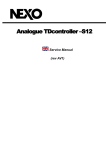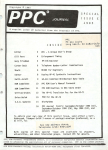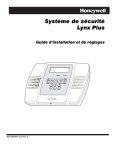Download I opened up the 7020, and found a cluster of 4
Transcript
I opened up the 7020, and found a cluster of 4 large blue caps (diam approx ½ inch each, height approx 1 inch, bundled together with a plastic tie). Of the four, two look like they have leaked... brown stains on the PCB just below. The leakers are C911 and C912. - John Curl recommendation: use Nichicon "MUSE" caps _____________________________________ but I would like to understand the trade-offs. If I go too high with C, what happens besides "bigger and more expensive"... what's the impact on performance? only downside is that when you turn the amp on the caps represent a short until they charge up (turn-on surge) -- too much C and you pop fuses when you turn it on. I generally use a 4x as big rule-of-thumb to avoid having to add circuitry to slow down the start up surge. The 70,000+ NAD i did was before i learned this, but that unit is still chugging 15+ years later and has never been a problem. _____________________________________ I opened up the 7020 last night to get an idea of how much room I have for those power supply caps... guess what???? I found a few more leakers. These guys have brown or black crispy crud lying in a puddle on the PCB or collected at the base of the cap. It's not solder flux, since the only components that have brown crud below them are light purple elelctrolytic caps (just like the power supply caps we've been working on). I couldn't tell who the manufacturer is... I don't have the viewing angle. ______________________________________ C911-C914 ???????? 4 2200uf 63v caps... these will fit and exactly replace the exing caps, 4 4700uf 63v caps to be added outside of the two fuses mounted to the PCB. This will reduce ESR (= effective series resistance??), give me flexibility if I need it, and boost capacitance to 3.1x original levels. C801 and 802 Simple replacement with good 50v caps of the specified value C901 and 902 I bought two caps for exact relacement, and two more to mount on the foil side of the board. So these will end up at 2x. DON’T DO IT! (s. l.) I also got two 10 watt 100 ohm resistors for burn in. ???????? ______________________________________ Here is the bit from David Klien: "The transistors are 2SD733 and 2SB557. They are 30-amp types, but their small-signal behavior matches the original devices, so no circuit changes are necessary. I pored through transistor manuals at great length before finding these types. They would be a perfect match for your souped-up power supply - even one Farad per channel won't help you if your output stage is in saturation." _____________________________________ I see a LOT of ceramic caps in the 7020... at some point I might want to replace most of those. My planned/potential mods to the 7020 are: - repair the unit to eliminate hum for all source switch positions - beef up caps in power supply and output stages (the stuff we've been talking about for two months) - upgrade bridge diodes in the power supply (Shottkys or FREDs... still reading and learning about this) - replace the captive AC cord, build J Risch AC Line Filter and Surge Supressor... so all of the additional filtering would be outboard, but I'd have a 14 ga shielded cord to the 7020. I'll check for the proper line polarity before I solder the cord. - remove the spring-loaded speaker terminals and replace it with good binding posts that take spades - possibly replace the female RCAs with good gold-plated Cardas or Vampire RCAs - upgrade all caps in the power supply and along/near the signal path Peter: C901 470uf, can't read the voltage C902 330 uf, 35v (I had to scrape the crud puddle away to read the number on the PCB for this one) Dave: Those are the input caps on the hi-level power-supply regulator board. These are on a board sticking up from the main board just beside the power-amp supply? It wouldn't hurt to go up to 2x on these. This is, no doubt the major source of hum. ---------------------------You were dead right. Last night, when I replaced C902, the hum was gone (there's still VERY low level hum from the phono section, audible with the volume CRANKED, and I rarely listen with the volume above the 10 o'clock position). There's a bit more hiss than I had with the leaky caps, definitely not audible at listening volumes, but there nontheless. And, we're not done with the surgery yet... I still have four more caps (C911-914) to replace. I'm intending to run color coded 12 ga solid copper wires out from the base of the caps (I think it's 911 and 912, but I'm at work and can't look to be sure) to serve as a bus wire for the additional caps I'll install in a couple of weeks. Does that sound OK? Right now, I'm planning on mounting the addtional caps (4x4700uf, 30x50mm) to the vertical part of the large metal heat sink for the power transistors. Sound OK? _____________________________________ I got C911-914 in Sunday night, but didn't get to listen until last night. To begin with, I had kind of a rude surprise... no hum, very, very little hiss, but no stereo on FM.... what the hell???? Of course, I thought that I might have bridged PCB foils with solder, or a long lead (I left a few to facilitate the next round of mods) was shorting something... anyway, stereo FM was restored when I wiggled the front vertical PCB on the right side of the 7020. There are two small vertical boards held in place with a vertical clip that engages the two boards at the top and holds them so that the PCB connectors at the bottom engage. The front board (towards the front of the 7020) had been pushed out of the clip during all of the chassis-flipping I did trying to find the right pads to de-solder, etc. I'm giving this to you in some detail so you will know the score if this happens to you. In terms of sound, things are still evolving. First, the hiss and hum I talked about last time are REALLY minor... maybe I've got something wrong with the headphone circuit, since I did the original listening with phones. Listening with my ear against the speaker drivers with the volume at full maximum, I hear a slight sizzle from the tweeters, a slight hum from the mids, and the lows are quiet. In the phono position, with the volume at max. I hear audible hum... sounds like a mixture of 60 and some higher overtone... 120, 180, 240 HZ?? This is definitely not audible at even very loud listening levels. So, we have fixed the 7020. I probably have less than 15 hours of burn-in, so the situation is still fluid. The 7020 sounds pretty much like it did before, after the initial hum had disappeared after warm-up. It does seem to be a bit cleaner here or there, in the occasional passage I hear something a bit better than I have before. Nothing dramatic, but the differences I DO hear are for the better. I guess that's what I'd expect for getting the machine back to its initial designed parameters, albeit with better capacitors in a few key places. Of the 8 caps I replaced, every one showed significant leakage (dark brown and crusty, spread out flat against the PCB, in half the cases, forming a puddle of crisp brown crud on the PCB. None of the other similar caps in the 7020 shows similar signs (but some are buried too deeply to see well), but I wonder if some of the others aren't on shaky ground as well. _____________________________________ Last night was Power Supply night at our house. The 7020's power supply PCB came out smoothly, encouraged a bit for starters with a little prying action using an offset screwdriver (long, "L" shaped, and perfect) under the edge of the PCB... I just went slow, and looked for small gradual movement. The PCB was out in less than a minute. There were 4 wires from the harness soldered onto the board, so I tagged those and removed them. - I replaced all but two (for those, I didn't get the right part... it was hard to read the values without removing the board) of the electrolytic caps with Nichicon muse of equal or higher voltage rating. - I replaced the steel jumpers with 24 ga teflon insulated copper (Belden Cat 5strands). - I replaced two ceramic caps soldered to the foil side of the PCB with metallized polypropylene caps (Multicap PPMFX, Michael Percy). - I cleaned the PCB mounting socket pins and receptacles with DeToxit and 5% ProGold. I also treated the fuses and fuse holders in the same way. (I need to remember to treat the main fuse on the back of the 7020 chassis too.) I'm going to let these caps burn in for a while, then I'll beef up the PS and filter caps as we've discussed (long ago now). While these are burning in, I think I'll re-do the power cord as follows: I'm going to start with a Volex (Belden) 14 ga shielded 3-wire cord, approx 10 feet long. I'll cut off the IEC plug, then strip the insulation off somewhere in the middle of the cord and build a Jon Risch AC line filter "around" the cord, The cord then continues into the 7020 where, after I figure out the correct polarity I'll solder it in. I plan to build this so the AC cord wires are never cut between the 3-prong plug and the 7020... so there's only one connection, and that's at the wall (a Leviton "industrial grade" socket... I haven't tracked down "hospital grade" yet). I will probably tap off a duplex outlet so I can also filter low power stuff (like the powered FM antenna and, for now, the CDP... eventually it will have it's own filter). _____________________________________ Date: Tue, 14 Nov 2000 10:51:54 -0600 Subject: cap questions I'm still in early burn-in (10 hours?) for all the electrolytic caps I've replaced in the power supply and phono stage (I also replaced 5-6 caps in the preamp), so things will continue to evolve. My early impressions are that the sound is less grainy now... it wasn't very grainy before, but I think it's smoother now. There's still plenty of shine in the strings and growl in the string bass, though. By the way, I really didn't have any idea WHAT to expect with the new caps... I was just trying to lay good groundwork before I beef up the PS caps... so I think this is real, not a psychology experiment. _____________________________________ Date: Fri, 17 Nov 2000 09:27:11 -0600 The 7020 is sounding really, really nice. To date, I've replaced C911-914 and 95% of the electrolytics on the PS and all of the electrolytics on the phono board. All jumpers on these two boards are now copper (22ga magnet wire on the PS board, 24g teflon insulated wire on the phono board). I've replaced a few ceramic caps on the phono board with Wima polypropylene, and a couple of the ceramics on the PS board with film caps. I also replaced a few (maybe 5) of the electrolytics in the preamp (I had some extra caps, the machine was open, let's go!). I will work my way through the preamp and power amp stages over time. The first thing I noticed was a significant decrease in graininess and glare in the sound. I had never really heard graininess out of the 7020, but now the sound is smoother still. I DID hear occasional glare in the upper midrange... in the last 3 nights of listening I have heard none at all. A few days ago, the sound was smooth, refined, and maybe laid back too much. In the last two nights, the sound has become just a bit brighter (that's good in this case, at least so far)... it is both more detailed AND smoother, equally capable of savagery and smooth seduction depending on the music. Last night we had some people over, and I was playing Keith Jarett's "The Night, The Music, and You." Last summer on Music Lane, someone posted a question about the sonics of this CD. I replied that it was one of my favorites, but the sonics are subdued... after all, what do you expect from a solo piano—specially modified for quiet playing--played quietly? Another poster commented that the sound of the piano on this CD became increasingly vibrant as he improved his system. So, last night, after the people left, I'm reading the paper, stewing about the Florida recount mess, three glasses of wine into a very nice evening, and NOT thinking about audio... but damn, that piano sounds WONDERFUL... not totally "there" yet, but clear evidence of significant progress. I'm very happy with the music in my house now, and we're only 10% into the project. Thanks again. _____________________________________ I can always tell when a change to my system has had positive sonic impact... when a CD I've listened to for 10 years, which has always sounded "good" (as in no complaints), suddenly comes alive after a change. When I went from straight Beleden 89259/Cardas GRMO interconnects to the Jon Risch recipe (slightly modified), it was Handel's Water Music and Vivaldi's The Four Seasons... suddenly the low strings had "bight," the character, the voice, of each of the strings emerged, and now I got the point... the artistic vision of the composer/musicians. With this latest round of PS (plus a few in the preamp) cap upgrades, it was my recording of Shubert's Unfinished Symphony that emerged from the haze... the smoothness (yet with clarity and definition) of the sound in this recording is incredible (now). Now it is emotionally engaging, before it was at some level background music... I had to work to stay with it... now it grabs me. Then I put on some Bach organ and got a surprise... significantly more and significantly better defined bass!! WTH??? I might have expected more clarity (from less distortion) from upgrading the PS caps, but I don't understand where "more bass" came from (so far, I have made no changes to the stock circuit, just put "better" caps in). _____________________________________ Date: Wed, 22 Nov 2000 08:44:51 -0600 Subject: Re: Schottky shopping <<Let it burn-in... but this is where the previous comment about upsetting the regulator might play.>> It sounded a lot better last night. I will just listen for a few days. After Thanksgiving and the parties the kids will have (they're home until Sunday night) the 7020 will be WELL burned in. Next week, when it's quiet again I'll listen HARD. If there's any doubt, I'll remove the added caps for a quick A-B test. I think the 7020 has become a very fine component... smooth, and quite resolving, it's a delight to listen to. It is also becoming increasingly sensitive to getting temporarily screwed up as new parts burn in. It will probably be a standard thing, the machine will loose focus for a few days after each change. When I did the first round of cap fixes and replacements, the improvement was so stark that "better" was obvious, parts burned in or not. Now, I will have to wait to be sure... the cost of progress, I guess. _____________________________________ Date: Mon, 27 Nov 2000 09:07:17 -0600 Subject: Re: eBay 7020 I went back to 1x on C901-902 last night. Burn-in progress had stalled out, and it did not sound good. With these caps doubled-up, there was a loss of clarity... most obvious in complex orchestral passages (also in multi-voiced pipe organ passages) the transparency that I had found just 10 days ago was gone. It sounded a bit like the 7020 couldn't quite keep up with the music. So, I pulled the extra caps, and sweetness reigns again. _____________________________________ !!!!! Last night I was going to replace a lot of crappy steel jumpers, etc., and I thought I'd start by replacing a large stranded (white insulated) jumper in the absolute northwest corner of the main PCB with 20ga solid copper. I de-soldered the wrong pad (this is only the second time that has happened in the hundreds of leads I've de-soldered by now), and I got one of the pads for Q612. Worse, a section of the copper foil pad came up with the soldering wick... it must have been broken off long ago and held in place by the solder fillet. No problem, there is an unused hole on the same foil section, so I'll just solder it there. So, I pulled Q612, and screwed up the orientation when I put it back in. In my defence, it's a dark corner back there, and the Q612 pins were pretty twisted, so "right way" was non-obvious. There were interruptions... blah, blah, blah...I just screwed up because I wouldn't take the time required to figure it out. Later in the evening, after the smoke had cleared, I figured out how I could have done this right. I had Q611 to look at, the pin configuration is in the schematic, pin "E" is called out on the board, and I have photographs that I took before I started... you should have seen me studying those photos with a bright light and a magnifying glass, like a spook looking at satellite photos of an enemy airbase... and after an hour of careful study, I figured it out. Too damn late though.... So, I put on the headphones, plugged it in, and turned it on. Huge hum and no signal from the right channel, apparently OK from the left. Power off in less than 5 seconds. Then I looked for a solder bridge, etc. de-soldered and cleaned up a potentially offending fillet, and tried it again. Same story. This time, I tried a few different sources (dumb, this is the power supply I'm working on...) and while I was doing that, I noticed a glow from the PCB. Instant power off, the glow dies, a wisp of smoke, and shit for brains. The little glow-worm was R646, listed at 180 ohms (Its partner, R645, is marked brown / gray / brown / gold = 181 ohms, 5%... and by the way, the board looks toasted--old toast though-- on this side too). I pulled R646, and it measures approx. 80 ohms now, but has obviously been fried. So, I'll look for a couple of 180 ohm resistors (I'll get 1/2 watt, and I think I'll stand them off the board since they are heating in normal use)... anything wrong with Radio Shack resistors? How important is 180 ohms? Michael Percy sells several 174 and 187 ohm (within 3.3 and 3.9% of 180) resistors that are probably much better than stock. All along, my alternative to fixing the 7020 has been to put a Foreplay together and buy a power amp. I can still do that, but I find that I REALLY want to fix the 7020 instead. Now that there's possible trouble, I'm surprised by how strongly I want to fix this little machine and make it sing. Audio is irrational, and they don't call it the Asylum casually, I don't think. Last night I replaced all of the busted and possibly busted parts in the right channel (even numbered parts). The left channel, all odd numbered parts, have not been changed since the "little glow worm incident." So, after checking everything 72 times, I plugged in the headphones and turned it on. Both channels alive, all functions functional. The 7020 is not anywhere near healthy though. After listening a few minutes to FM via a dipole I keep at my workbench, I thought it sounded a bit fuzzy. Before, I was often thrilled with the sound of the 7020 with these headphones and this dipole, but it might be a bad night for reception. I hooked up some old, very cheap speakers (just to be sure that I wasn't going to fry my good ones) and then moved out to the main system. After listening 15 seconds to one of my reference CDs, it's obvious that I have major levels of distortion now. Casual listeners might not notice (some would) but it's pretty bad, nothing like the sound I had before I began the initial work on the 7020, and 10 million miles from where I was before I screwed up. I haven't allowed the system to burn in (maybe 30 minutes so far), but the sound is so bad that full recovery from this would be the burn in story of all time. The symptoms: 1. Noticable distortion (as soon as the music is complex... for example when the full orchestra comes in) in BOTH CHANNELS. I've tested this via the balance control, not by just driving one channel (not yet, anyway). 2. More hum and different hum in the phono section. Before, there was hum in phono, but it was VERY low level. Now it is noticably louder (still not very loud though) and there's an added component... like a rapid beat frequency that makes the hum sound a bit like an engine running, with a certain throatiness to the sound. This leaves me wondering if I've cooked part of the power supply (distortion on both channels, not just the one I worked on, plus hum in phono). Last night I found and fixed the source of the distortion in the 7020. I was looking at some "dumb possibilities" that lurked in my mind as possible causes... things to eliminate before embarking on a full PCB sweep. I had used a ton of heatsink grease on the big output transistors... was that partially shorting them out??? I took them out, cleaned up the mess and put them back in. Fire up the machine, this time with SoftClipping = Off. Hey... sounds pretty good (with headphones and FM dipole). I think I'll take it out to the main system and listen for a while, but let's look around some more. With SoftClipping = On, there's a noticable volume drop and increase in distortion. The 7020 didn't behave this way before the big screw-up... with SoftClipping = On the music used to be sweet and clean. So, I removed the small SoftClipping PCB... maybe a fried part on that board... I looked at every part on the board for signs of excess heat or other trouble... no clear evidence, so I put it back and screwed it in place. I'll work on this later... Hell, I can replace every part on the SoftClipping board for less than $10.... Time to go test this thing on the main system. But there's a big "oh shit"... a 5-inch piece of white hook-up wire that comes from the SoftClipping PCB is just hanging out there in space... I must have broken it loose. The wires coming from the SoftClipping board are letter coded, and there are matching letters on the main PCB. The free-spirit wire comes from position M on the SoftClipping PCB... AND there's an empty M location on the main PCB.... right next to Q614. Actually, the empty M position has solder in the bottom of it's PCB hole, and it's been that way for a while because I've noticed the empty hole (with solder in the bottom) several times while I've been looking at nearby parts and their orientation. But... the pictures I took (before I ever got the solder iron hot) show a wire going into the PCB right behind Q614... so I soldered the hookup wire into main PCB position M, and listened to sweet music again for several hours last night. Your suggestion to set SoftClipping=Off led straight to the solution. I must have accidentally pulled the wire while rooting around looking at parts and their orientation. It may have been a partially bad solder joint, since there's no sign of fracture on the end of the hookup wire. I certainly didn't see it just hanging around though... it must have been tucked behind something, more or less out of sight, not to be discovered until I removed the SoftClipping PCB. I wonder if something like this isn't behind the distortion you see with your 3155 with SoftClipping = ON... a cold solder joint or a wire almost pulled out. Just a thought. ______________________________________________________________________ So, I'm back to replacing the rusty steel jumpers, the ceramic caps, and installing new transistors in the left channel to match all the new stuff in the right channel. Then I'll install good film caps at C603-C606 and bypass C909-910. Finally, the big filter cap increase at C911-914. Schottkys should arrive in mid-January. _____________________________________ But the music is best ever out of the 7020. Break-in was a bit uncertain, a bit too subdued at first, but more coherency, clarity, and texture has emerged in the last three nights (it's still very smooth overall), I heard a new line in the bass (Bach organ prelude) that I've never noticed before. _____________________________________ Thanks... While I probably will go ahead and do the active XO / biamp thing, sometimes I feel drawn to the relative simplicity of a maxed-out 7020 all by itself. The music last night was SO good (and the machine is still basically "stock with better caps and jumper wire")... How much difference in amplifier input sensitivity can the active XO compensate? I assume that I can put resistors or a pot in the XO for each amplifier... from the service manual the input sensitivity for the 7020 (high level) is 30mv/watt, for the C270 it's 9.2mv/watt. Now the C270 advertises "variable inputs", but that would probably decrease its sensitivity. I don't need to resolve this particular example right now, but I do want to get an idea of how much difference in input sensitivity between amplifiers I can accommodate. After I've got the amplifier input sensitivities leveled out, I still need some adjustment range to play with as I listen. _____________________________________ I thought I would take 30 mins last night and put in my Schottkys (PS board, I'll do the unregulated bridge later)... not so fast, Sparkie!!! The leads were too damn big to go through the PCB holes, so I made lead extenders from a double run of 24ga copper, and the spacing is tight, so I used heatshrink (in addition to the ceramic spacers) to reduce the odds of shorts... on and on and on... a couple of hours of brain surgery when I'd expected 30 minutes of cruising. So, I listened only for a few minutes last night. The Schottkys seem to have provided more edge to the sound, possibly at the expense of clarity. I let the machine burn in overnight and this morning I listened for a few minutes... it may have smoothed out some, I'm not sure. The 7020 is running now, and I'll listen more closely tonight (should have 16-18 hours of burn-in by then). I will probably leave the Schottkys in for a month or two, then swap in some Harris FREDs... see what I like best. _____________________________________ (The Schottkys) I bought from Digi-key: part no 50SQ 100-ND, 100v 5amps in DO-204 package (looks like a fat resistor) I opened up the 7020 last night. The distortion was due to an intermittent disconnection between the PS pcb and the main board. Wiggle the PS board, and it sounds fine. A few weeks ago, I was probing around on the back side of the main PCB with a voltmeter... looking for the voltage across the unregulated diode bridge. When I touched the foils, I heard (headphones) scratching noises and the sound changed character, becoming "fuller" or "more thin" as I poked around. (During normal listening, I had heard occasional spontaneous crackling... I thought that one of my new capacitors might be bad... but which one??? ... horrible thought. Also, sometimes the sound was less involving, but the fault was hard to put a finger on... maybe I'm just not in the mood to listen tonight...) The sound shouldn't change as I probe the board, so I probed some more, and eventually concluded that the problem lay with the connectors/pins between the PS and the main boards. I posted at AA (looking for suggestions, got stony silence... the atmosphere there is sometimes a bit rarified for my taste) and eventually re-soldered all of the pin and socket connections on the two boards. Problem apparently solved, because the machine now sounded great no matter how much I wiggled the PS board. No scratching noises, either. Last night, I cleaned the pins/sockets some more with ProGold, and things seem "fixed" for now. I'll just have to wait and see for a while. If that doesn't do it, I wonder what the next step is... _____________________________________ Over the last 6 weeks or so, I put in some Schottkys in the regulated bridge, felt that they were super-detailed and that there was a layer of grunge... maybe newly audible because the Schottky's had removed a different layer of grunge?? So I put in the Harris FREDs (8A 600v). Those sounded a lot nicer, much more musical. But there's still a grunge layer... loss of clarity in complex passages. Massed strings get fuzzy at fairly moderate levels... And then there's the start-up thump (with lab-in, but not with normal-in). You suggested that I pull the soft clipping board. So, I worked out the signal traces and the jumper wires, checked things out with a VOM, and cranked up the solder iron. First thing I see is a bad solder joint for jumper I at the main PCB... a small crack in the solder (source of grunge???)... I don't know. I just pulled the damn board, soldered in new R701 and 702... sounds very, very nice. Grunge mostly gone. The start-up thump is still there though. I might start tracking that down by replacing C601 and 602. Next is to upgrade the unregulated bridge. I saw a post on AA recommending a filter cap maximum of 10,000uf per 100 amps of surge current capacity in the diodes to cover startup.... and I want to add something like (4700 + 2200)*4 = 27600uf... I might try the Schottkys I have, they're rated at 290 amps nonrepetitive surge. They're only 100 volts though. I measured 60v across the AC... so 60*1.414 = 85 volts... do you think 100v is enough headroom? What happens if one of those diodes blows? I ordered an AKSA (55w standard issue). Have you placed the order for the UG10DCT/ BYQ28E-200 rectifiers yet? Just checkin... Gotta scoot.... go home and play some tunes. _____________________________________ Hi Dave, I spent the week listening to the 7020 with the soft clipping board removed... the sound was extremely transparent and resolved. After a few days, I thought it might be too much of a good thing (detail = surgical and clinical??? worry, worry, worry...), so on Wed night I put the board back in and re-wired it. Two more days of listening... is this more musical, or what? Nope...it's more mushy, way more mushy. So, Friday night, I pulled the board again, and I'm definitely happier this way. It's really a huge change. I think I'm going to pull the speaker switch and replace the speaker binding clips with the Cardas binding posts I bought long time ago. I'm getting tired of trying to jam all those free copper strands from my speaker wires into the clips... I'll put some large spades on and fix that problem, and pull some more wire out of the 7020 too. I think I'll build the AKSA as monoblocks. I'll build one side as a prototype (on plywood with an aluminum cookie sheet screwed onto it)... that way I can try a bazillion layouts, check for hum, etc. Once I've got a layout that I'm sure works, I'll build it on a 1/2 inch aluminum slab and put it in a ventilated box. I'm thinking about tucking them behind my speakers (1.5 foot speaker cables and 4.5-5 foot interconnects, not too bad). If I do that, I will keep the AKSA boxes very plain, maybe just a flat black box with a grille on the top. What's the quietest way to do a "power on" light? _____________________________________ From Allen Wright: "You sent me a 7020 map. Suggestions: 1/ You hi-lited the "Norm In" section. I'd leave that alone and simply go in via the "Lab" input. That bypasses all the filters but leaves the vital bias network intact. But hard wire this connection at the PCB - don't use that thick link at the rear panel sockets 2/ Put circa 10nF/63V MKP bypass caps across ALL the elkos in the signalpath. They will need to be small to fit and not get in the way too much. There are LOTS of them, so this will make a remarkable change. Otherwise change all the coupling elkos to Blackgates - but thats like goldplating the engine compartment of a Datsun... 3/ Biggest change I ever made to old NADs was to short out on the PCB EVERY switch I could find that wasn't ABSOLUTELY essential, especially the stupid speaker selecting switches. 4/ Add lots of extra poweramp capacitance - but only use hi-freq caps intended for switch mode powersupplies. Extra regular elkos loose as much sonics as they add. Wire them in with foil rather than wire - doesn't have to be silver - and bring it RIGHT to the O/P transistor connections. 5/ Trick diodes are a minot tweak for the reg supply but VITALLY needed to replace the output P/S's bridge (BD901/KBL02) - Schottky's if you can find them - otherwise fast/soft ones with plenty of current reserves! The 3020/7020s are inherently wonderfully musical devices - pity they didn't make a really basic version with NO switches, tone controls etc etc etc!" ________________________________ Hi, Tweaking a 7020 was my first real audio project, and I got lots of help from people on this board. The tweaks that made the biggest difference (in my system, with the music I listen to, etc,) were: 1. Power supply diodes. There is a large monolithic rectifier bridge by the four power supply caps. I replaced that with four FRED diodes (now you could use Schottys or Stealth diodes). There is also a bridge in the regulated power supply (on a seperate board). Replacing those with FREDs greatly reduced grit and glare. 2. Power supply and coupling caps. I used Nichicon Muse and got more high end extension. I also doubled the power supply capacitance and did not hear a large effect (but I was using 94db efficient speakers at the time). 3. I removed the Soft Clipping board. You want to get a schematic before you do this, because you can't just pull the board and be done with it... it's been a while, and the details are sketchy, but a look at the schematic will make things clear. I still have the 7020.... it's in daily use by my wife who absolutely loves that little rig. I love it too, but she's got it, so I've been forced to build AKSA amps and Orions... Peter Posted by PSP (A ) on January 17, 2006 at 12:20:37 In Reply to: Re: NAD 7020 mods? posted by bjamesw on January 17, 2006 at 11:05:10: I think only the electrolytic capacitors will get old... I eventually replaced all of them (but I didn't mess with those in the tuner section since I wasn't sure if I'd screw up the tuner alignment). I used Nichicon Muse (very good, and not extremely expensive). There are a lot of steel jumpers, most of them rusty. I replaced those with teflon-insulated 24awg solid core copper (strands from Belden 1585A cat 5 wire). I can't say that I heard a huge difference, but steel and rust can't IMPROVE the sound... You could also try nice film caps (if they will fit) for the coupling caps in the signal path... that was on my tweaking list, but my wife asked for the 7020 before I got all of that done. The rectifier diodes will last forever unless abused, but new-technology diodes (FREDs, Schottkys, etc.) sound very much smoother. I noticed a huge difference here. I think it was this change that gave me an inkling that tweaking really could bring major sonic improvement. Stock the 7020 is very nice, tweaked it's nicer still. At one point, I was using a Foreplay preamp to feed the 7020s amplifier section... that was a big improvement. For $25, you have done extremely well. Tweak slowly, listen as you go. Some tweaks that "everybody" recommends will likely have no effect to your ears, or sound worse. Enjoy the journey. Change the volume pot for a good unit like the alps blue. I swapped out the vol pot of a 3020 for a conductive plastic type from bournes. The result was that the archetypal warm laid back sound disappeared replaced with a full fast clean dynamic one. This was a complete suprise as I had no idea that the vol pot was going to have such a huge influance on the sound. Look at the signal input the sockets are particularly poor on the 3020. Also signal tracks on the pcb are not ideal. I cut these taking the signal straight from inputs to the front controls via good quality cable[ptfe silver plated copper] with good results. Look at psu cap at the age the unit is these will mostly have dried out replace with good quality ones and up the cappacitance by no more than 20% but bypass the units with values of 10% ie if a cap has a value of 1000uf use a 100uf followed by 10uf and a 1uf [total increase will be 111uf]. I often miss out the mid value [10uf] as it seems to have the least effect. The theory is that smaller caps will react quicker to charging and the signal applied. The consequence is to improve the leading edges of the music as the amp reacts quicker to transients in the signal. The smallest cap will also be better at shorting RF noise.





















